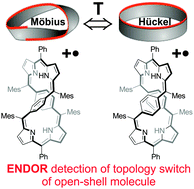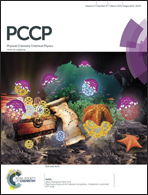Möbius–Hückel topology switching in an expanded porphyrin cation radical as studied by EPR and ENDOR spectroscopy†
Abstract
The symmetry of the arrangement of objects has fascinated philosophers, artists and scientists for a long time, and still does. Symmetries often exist in nature, but are also created artificially, for instance by chemical synthesis of novel molecules and materials. The one-sided, non-orientable Möbius band topology is a paradigm of such a symmetry-based fascination. In the early 1960s, in synthetic organic chemistry the interest in molecules with Möbius symmetry was greatly stimulated by a short paper by Edgar Heilbronner. He predicted that sufficiently large [n]annulenes with a closed-shell electron configuration of 4n π-electrons should allow for sufficient π-overlap stabilization to be synthesizable by twisting them with a 180° phase change into the Möbius symmetry of their hydrocarbon skeleton. In 2007, the group of Lechosław Latos-Grażyński succeeded in synthesizing the compound di-p-benzi[28]hexa-phyrin(1.1.1.1.1.1), compound 1, which can dynamically switch between Hückel and Möbius conjugation depending, in a complex manner, on the polarity and temperature of the surrounding solvent. This discovery of “topology switching” between the two-sided (Hückel) and one-sided (Möbius) molecular state with closed-shell electronic configuration was based primarily on the results of NMR spectroscopy and DFT calculations. The present EPR and ENDOR work on the radical cation state of compound 1 is the first study of a ground-state open-shell system which exhibits a Hückel–Möbius topology switch that is controlled by temperature, like in the case of the closed-shell precursor. The unpaired electron interacting with magnetic nuclei in the molecule is used as a sensitive probe for the electronic structure and its symmetry properties. For a Hückel conformer with its higher symmetry, we expect – and observe – fewer ENDOR lines than for a Möbius conformer. The ENDOR results are supplemented by and in accordance with theoretical calculations based on density functional theory at the ORCA level.


 Please wait while we load your content...
Please wait while we load your content...